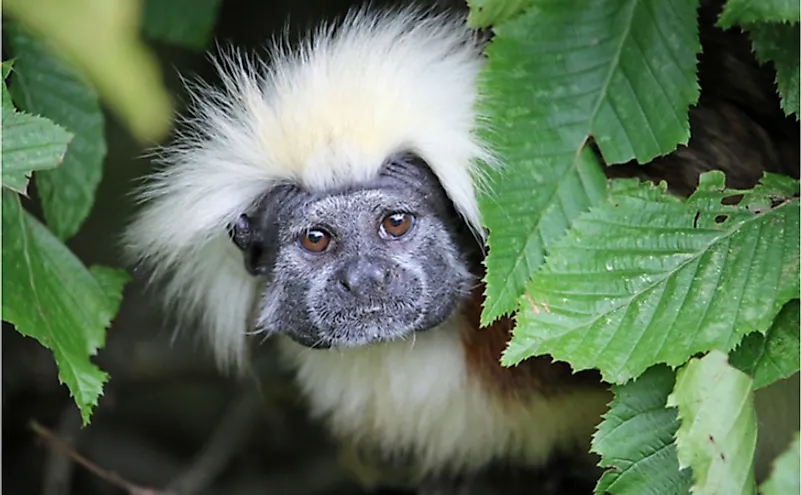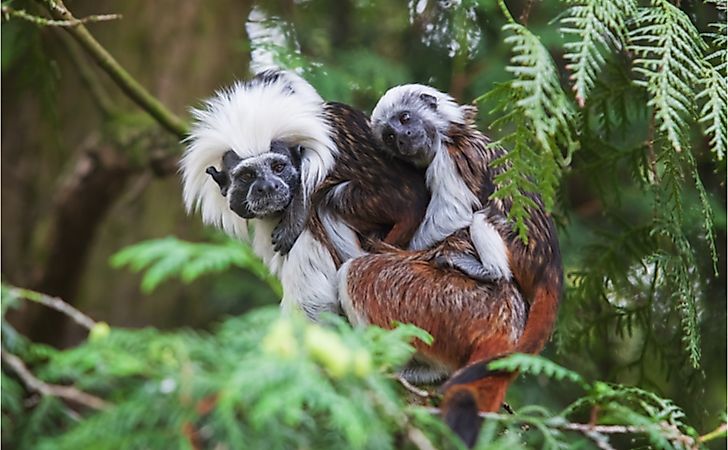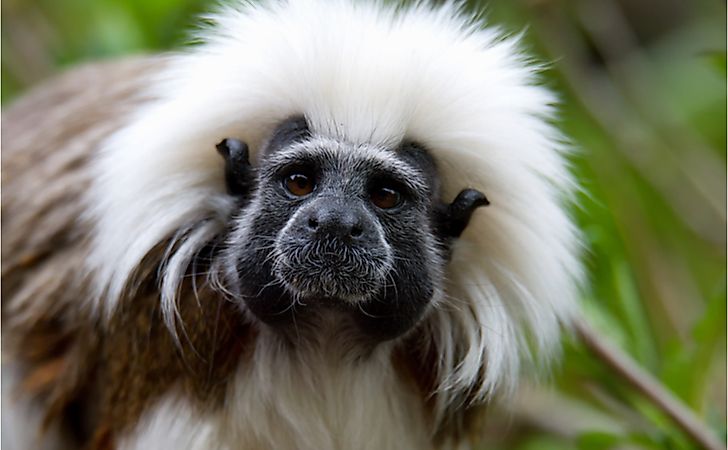Cotton Top Tamarin: A Beauty We Might Never See Again

The cotton-top tamarin, scientifically known as Saguinus oedipus, is a critically endangered New World primate endemic to the tropical forests of Colombia. The species is called titi or titi Piel Roja by communities bordering the northern part of its range and bichichi in the southwestern region. The native name in the south is, however, used to refer to Saguinus geoffroyi, another distinct species. The cotton-top tamarin derives its name from the large mane of cottony white fur on its head. The feature makes the species one of the most striking primates in the world. First described in 1758 by Linnaeus, the cotton-top tamarin is often wrongly referred to in several works of literature as the Cotton-top “marmoset.” The small arboreal monkeys are currently found in an extremely restricted area that stretches from the Atrato River to the Magdalena River. The habitat typically consists of both humid and dry tropical forests. There are currently about 7,500 cotton-top tamarins remaining. Human activity, including deforestation, and hunting, has, over the years, led to a drastic reduction of cotton-top tamarin numbers and is now threatening to wipe out the species entirely. With much of the world focused on the disappearance of the ape populations in Asia and Africa, the plight of cotton-top tamarins has often gone unnoticed.

Hunting And Capture
Between the late 1960s and 1973, an estimated 20,000-40,000 cotton-top tamarins were captured and exported to several countries, including the United States, for use in biomedical experiments. The unique history and physiology of the species turned out to be its curse as they are considered essential primate models for biomedical research. Their extreme susceptibility to a variety of viruses makes them invaluable in the study of pathogenesis in certain human diseases. For example, the species is used in the research of numerous maladies, including colon cancer, colitis, and Epstein-Barr virus. The species is considered indispensable in the study of colon carcinogenesis and colitis since it is the only primate model which, like humans, spontaneously develops colitis before and in most cases accompanying the onset of colon cancer. Cotton-top tamarins also seem to be far more susceptible to fatal measles virus infections and retrovirus-induced sarcomas than other species. Although legal capture has been banned, illegal trade and trafficking continue. Research institutions and zoos have also begun to manage the species sustainably, but there are incidents of deaths of captive cotton-top tamarins as a result of negligence.
Deforestation
Habitat destruction through deforestation represents one of the greatest threats facing the cotton-top tamarin. Colombia ranks as one of the top ten countries worldwide in terms of deforestation. The country loses nearly 1544 square miles or 5% of tropical habitat every year. The alarming rate of deforestation is attributed to swidden agriculture, extraction of forest products for traditional and subsistence use, clearing for large scale agriculture and cattle rearing. The forests on which the cotton-top tamarins rely on have, over the years, been reduced to an estimated 5% of its former geographical range. Cotton-top tamarins have been left with just a small fraction of their former home.
The regions of the country where the species is found are also among the most densely populated areas. There are fragments of forests in the region that hold remnant populations of primates, but only three high-quality forest blocks remain. The cotton-top tamarin seems to adapt to the highly disturbed habitats. Experts, however, believe that if deforestation is not halted and restoration of the habitats is not prioritized, the species will eventually have no place to live.

Subsistence Forest Extraction
While extraction of forest products using traditional methods does not involve the same level of overt destruction of habitat as large scale clearance. However, it does pose a significant threat to the species due to the targeting of tree species vital to their feeding ecology. The extraction of species that persist during the dry season can particularly be detrimental to the species during stressful times of the year. The destruction of the understory for firewood or charcoal can also have damaging consequences for the species as it results in the removal of a layer that has many insects (an essential source of nutrition for the cotton-top tamarin). In impoverished areas where firewood is the primary source of cooking fuel, a family of five can consume up to 15 logs of wood a day. If the wood is obtained from a cleared part of the forest and no replanting is done, it is understandable how large sections of the forest can be cut down, resulting in the loss of the Cotton-top tamarin’s habitat.
Oil Exploration
The exploration of oil in the lowlands of Colombia is a growing threat to the Cotton-top tamarin. The region has considerable hydrocarbon reserves that the government is keen to exploit. Experts believe that the economic boom associated with the extraction will lead to a mass migration of people into the area in search of jobs. The influx of people will likely cause considerable strain to the environment as it struggles to cope with the increased population. The high population is also likely to lead to more roads and settlements in the forest.
Hydropower Generation
Hydroelectricity accounts for nearly 70% of Colombia’s power needs. The country currently exploits only 6% of its hydroelectric potential. Although the nation’s power sector has historically avoided projects that may lead to significant negative social and environmental impact, the ever-growing population and resultant demand for electricity will make that record hard to maintain.
Natural Disasters
Natural disasters such as drought have been observed to cause damaging effects on the cotton-top tamarin population. During periods of severe drought, a majority of cotton-top tamarins fail to deliver viable offspring. In some severe droughts, pregnant females do not give birth to viable infants. Scientists have concluded that environmental stress as a result of events such as drought can lead to potentially harmful effects on the small and fragile populations of the cotton-top tamarins. Scientists have also predicted that such adverse natural events are likely to occur with increasing frequency due to climate change, which could potentially lead to the extinction of the species.
Intrinsic Factors
Cotton-top tamarins have offspring survivorship of about 86% in the wild. The decline and fragmentation of their habitat mean that dispersal may be limited, and offspring survivorship may decrease due to increased inbreeding among the isolated populations in fragmented parts of the forest. Inbreeding can particularly have devastating effects on a small population due to inbreeding depression and genetic drift.
Civil Disturbance
Civil disturbance by paramilitary operations and guerrilla fighters generally has adverse effects on primates such as the cotton-top tamarin as well as other forest-dwelling animals. Such disruption can lead to increased pressure on tamarin populations as a result of hunting by both fighters and displaced populations. Territory under the control of armed fighters is often used for the cultivation of illegal drugs, which requires that forests are cleared. Since the drug trade in Colombia and abroad continues to be lucrative, armed groups are encouraged by the economic incentives of the drug business to keep cultivating such crops on larger tracts of land to sustain the demand. Civil unrest also prevents researchers from maintaining their presence in several areas within the cotton-top tamarin’s range. Some experts have argued that civil disturbance by guerrilla fighters has, in some cases, had a positive effect on cotton-top tamarin populations. They assert that the unfortunate displacement of locals from their land helps stem the exploitation of the forests for firewood and agriculture by the local population. The argument is, however, faulted by those who believe in more sustainable approaches to conservation. The disturbing truth in the argument also sheds light on the precarious existence of the species, which often has to bear tragic losses due to the civil disturbance.
Conservation
In line with recommendations from experts, the Colombian government has declared protected areas for the species in northern Colombia. Organizations such as Proyecto Titi have launched innovative exchange programs where locals exchange slingshots used in hunting the animals, for stuffed cotton-top tamarin toys. In remote villages, such toys provoke a lot of interest from residents, and the result has been a significant decline in the hunting and capture of primates for the illegal pet trade. The organization has also led to the development of the Colombian National Conservation Plan for Cotton-top tamarins. The document outlines the critical need to protect forest habitat. Proyecto Titi has also been instrumental in preventing the construction of a new airport that would have potentially led to the clearing of hundreds of acres of tropical forest. Several classroom and field activities have also been developed to increase awareness and interest in cotton-top tamarin conservation activities. Strategies that reduce the community’s dependence on forest products are also being developed. Binde, a traditional cooking apparatus, has been innovatively modified to function like a small cook stove that significantly reduces the amount of firewood consumed in a day. Locals now collect fewer logs or spend less purchasing firewood. If the species is going to survive in the coming years, more proactive and sustainable strategies need to be developed. It would be interesting to see the ecotourism conservation model utilized in Colombia as it has been effectively utilized in the conservation of mountain gorilla in Rwanda.











